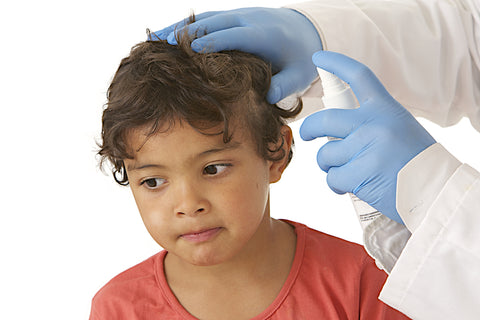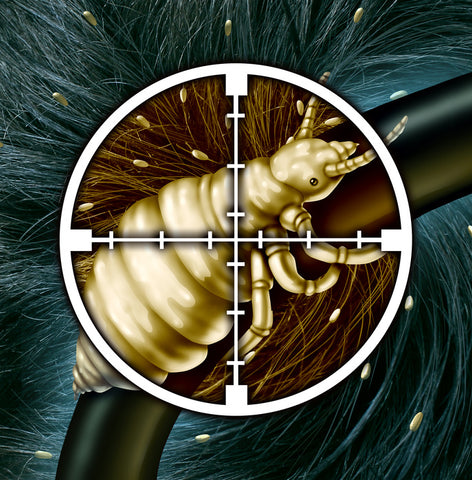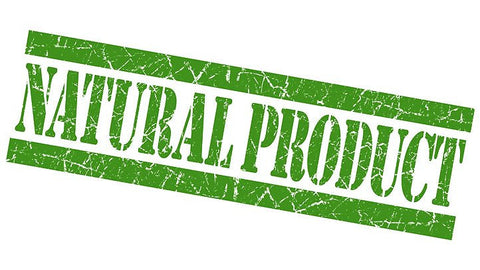Chemical Treatments are Dangerous - LiceGuard

The panic you feel when you find out that your child has lice is palpable. Your heart starts racing and sinks to the floor, you scratch your head as you imagine that you must have lice too! You become overwhelmed with the knowledge that there are lice in your home and that you need to clean everything immediately. So you race to the store and buy the harshest chemicals you can in order to kill all the bugs as fast as possible!
However, that is just the fear causing you to act. Stop, take a deep breath and weigh your options. It is best to be knowledgeable about lice treatment options if you really want to get rid of lice safe and effectively.
The truth is that most traditional over-the-counter chemical lice treatments are ineffective. Lice have evolved over the years and have become resistant to these chemical treatments. In recent years, news outlets have heavily discussed the topic of Super lice, the new strain of critters that cannot be treated with traditional chemical lice treatments.
While Super lice have been getting much press lately, the treatment of Super lice goes back fifteen to twenty years. John Clark, a toxicologist at the University of Massachusetts at Amherst, has been warning parents and professionals about just this phenomenon. A September 12, 2002 article published by the University states the following:
“Most commercial anti-louse shampoos are based on the pyrethrins, an extract that is derived from chrysanthemums which has low toxicity to humans. The problem, according to Clark, is that similarly acting compounds, such as DDT, have been used for more than 60 years in getting rid of lice, and more and more of the insects, which live only on human heads, are surviving the treatments. Essentially, lice vulnerable to the treatments are being slowly killed off, and those that can withstand it are surviving and reproducing, creating a strain of hardy survivors. That translates into a best-case scenario for the lice, and a worst-case scenario for humans, said Clark, who points to studies finding that 50 to 98 percent of the parasites remain after being exposed to these insecticides.”
Sitting in 2017, we have arrived at the worst case scenario: lice are no longer succumbing to traditional chemical lice treatments and we are exposing our children to these chemicals. Chemicals, it should be mentioned, which we are advised to apply with gloves on our hands to our children’s scalps with no promise of actually solving the problem. To make matters worse, chemical lice shampoos do nothing to lice eggs (nits) and thus the cycle of lice in our children’s heads continues.
Product watchdogs Consumer Reports recently published an article with the following findings, “There’s no reason for parents to douse their children’s heads in chemicals,” says Urvashi Rangan, Ph.D., Director of Consumer Safety and Sustainability for Consumer Reports. “Physically removing lice, while it seems daunting, is safest for your child’s head.”
The toxic over-the-counter products are losing their fight against lice because studies suggest that most of the bugs in the United States have evolved to become genetically resistant to the insecticides found in those products. That includes pyrethrum in shampoos such as RID and the permethrin in creme rinses such as Nix. Pyrethrum is a naturally occurring pyrethroid extract from the chrysanthemum flower, and permethrin is a synthetic form of that drug. Products with those toxic ingredients have been available to consumers for decades!
A study published in the March 2014 issue of the Journal of Medical Entomology found that 99 percent of the head lice collected by school nurses and professional lice combers in 12 states and three Canadian provinces were genetically resistant to permethrin. “It’s not surprising that we are seeing a resistance to these products,” Rangan says. “That’s what happens with insecticides and pests over time.”
Luckily there are other safer, more effective options to treat both lice and Super lice. While you can find many home remedies for lice treatments, such as garlic, mayonnaise, petroleum jelly, coconut oil and many other substances people swear by, it’s best to read up on what the experts recommend. Most of the home remedies won’t do much more than frustrate you and your child and make a stinky mess.
The tried and true best way to eradicate lice is with time and patience. Though it may feel counterintuitive, we know there must be a physical removal process to break the cycle, and that takes time. A good lice comb and a conditioning shampoo that loosens the nit glue will get rid of lice and the eggs. Make no mistake, there is no silver bullet, it’s a long process. However, for the safety of our children it is so very worth it! Diligent and consistent combing daily for 14 days will safely and completely eliminate the infestation.
Want a NON-TOXIC and proven way to protect against lice infestations?
Buy the RobiComb® Today and Kill the Lice on Contact!
No Chemicals. Safe for Kids.
Buy Today at Your Local Pharmacy
- Carson Shopify












Comments 0